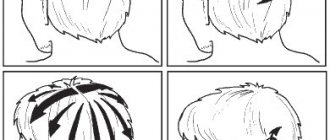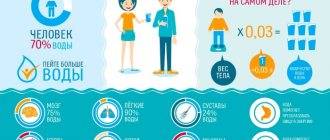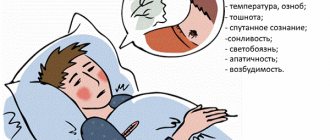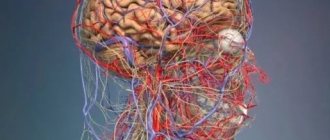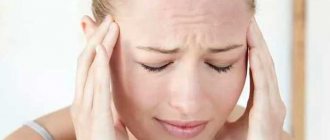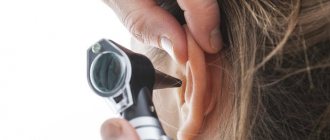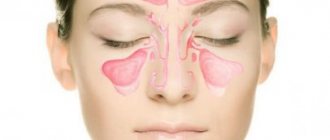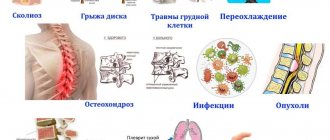If an obstacle appears in the path of blood flow, a feeling of pulsation may occur or, as the patients themselves describe this symptom, the blood “knocks” in the temples and back of the head. This symptom is not specific only to the brain; its appearance may also be preceded by diseases of the heart and arteries - aortic valve insufficiency, hypertension.
periodically feel pulsation during the release of stress hormones, when exposed to the open sun, or when drinking alcohol. More often it is not accompanied by pain or heaviness in the head, or these symptoms go away after resting and taking sedatives.
The most common pathologies with similar symptoms are: osteochondrosis; cardiopsychoneurosis; hypertonic disease; arterial hypertension due to pathology of the kidneys and endocrine organs; atherosclerotic changes in blood vessels; migraine; vasculitis; brain tumors; aneurysmal dilatation of arteries; abnormalities in the development of the vascular network; diseases of the ENT organs; decreased vision, glaucoma.
If the sensations occur at night, patients feel weakness, headaches, ringing in the ears, and palpitations may be due to hypotension and hypertension. Due to the uncomfortable position of the head and osteochondrosis of the spine, shooting pains and a sensation of pulse occur at night.
An intense headache occurs during a migraine attack. Moreover, most often patients note it on one side. May be accompanied by nausea, vomiting, visual, sensory and motor disturbances. Intensifies when walking, climbing stairs, before menstruation. In children, the first sign is drowsiness, and after sleep they feel better.
If there is also noise in the head, pulsation, dizziness, sleep disturbances, headache, then these may be signs of atherosclerotic vasoconstriction . High blood pressure due to hypertension or symptomatic hypertension can also be manifested by pulsation in the head and ringing. The cause is damage to the kidneys, thyroid gland, adrenal glands and pituitary gland. A constant throbbing headache in the same place of a bursting nature with nausea, vomiting, and convulsions raises suspicion of a tumor process in the brain tissue.
to start an examination with a neurologist, especially if you have headaches and tinnitus. If vascular pulsation is accompanied by increased heartbeat, pain in the heart area and fluctuations in blood pressure, then a cardiologist may be the first doctor. To exclude diseases of the ears and sinuses, a visit to an otolaryngologist is required. In case of vascular pathologies of the brain or high blood pressure, the patient is referred to an ophthalmologist.
Examination methods: general clinical blood and urine tests; blood biochemistry – renal complex, cholesterol and glucose; coagulogram; electroencephalogram; blood pressure and ECG monitoring; rheoencephalography; Ultrasound of blood vessels of the head and neck, heart; CT and MRI of the brain.
Treatment for pulsation in the head. For high blood pressure, antihypertensive therapy is prescribed (beta blockers, ACE inhibitors, diuretics). Neurocirculatory dystonia requires mainly non-drug methods - lifestyle correction, soothing physiotherapeutic procedures, therapeutic massage. The latter method, in combination with reflexology and anti-inflammatory drugs, is used for osteochondrosis. Migraine headaches and throbbing are relieved with painkillers.
In case of atherosclerotic artery disease, it is recommended to make changes to the diet. Medicines are needed with a lipid-lowering (lowering cholesterol) effect. For dyscirculatory encephalopathy (a consequence of atherosclerosis), complex therapy is prescribed, including vascular and neuroprotective medications, anticoagulants (blood thinners). Tumor processes, aneurysm, and malformations are treated primarily surgically.
Read more in our article about pulsation in the head, its causes and treatment.
Reasons for appearance
A throbbing pain in the head may indicate the presence of a disease. Cephalgia can occur due to environmental exposure and irritating factors. Isolated cases of pain are the result of a stressful condition, but periodic and intense pain is a symptom of serious illnesses.
Diseases that cause throbbing pain in the head:
- Diseases associated with visual impairment. Painful sensations accompanied by acute perception of light and nausea can be caused by increased intraocular pressure. When wearing glasses, lenses and other devices of incorrect diopters, the optic nerve is strained, which leads to spasm. The disease appears when wearing optical instruments for a long time.
- Chronic arterial disease. Headache can manifest itself in the area of the temples and the back of the head, which indicates a disease of the vascular system. Cephalgia is a residual phenomenon of high or low blood pressure.
- A common cold can cause sinusitis and sinusitis. Pus accumulates in the sinuses, which leads to pain. To avoid complications, you need to treat a runny nose. You also need to carefully monitor the location of the pain - if you experience unpleasant sensations in the back of your head, it is recommended to consult a doctor; meningitis is possible.
- A decrease in cerebral vascular tone leads to stagnation of blood in the arteries and capillaries. With vegetative-vascular dystonia, the pain is not localized in a specific place, but spreads to a point. The pulse does not affect the distribution and intensity of pain.
- Throbbing pain in the head can result from a migraine. A characteristic feature of this disease is the feeling of something foreign under the skin. The causes of migraines are not known. The disease can manifest itself in the presence of irritants (the smell of ammonia or paint, noises and screams, staying in an uncomfortable position for a long time, stressful conditions, a strong reaction to changes in weather conditions).
- In stressful conditions, a person experiences emotional tension. The pain spreads throughout the head. In such situations, it is necessary to resort to meditation and relaxation. To make the headache go away, you need to take a comfortable position, keep your eyes closed for a few minutes, or eliminate the irritating factor.
- A dangerous symptom, which manifests itself as sharp pain in a certain area of the head and may be accompanied by vomiting, is the appearance of tumors in the brain. Pain that has similar symptoms but occurs when a specific area is touched may be associated with traumatic brain injury. It is recommended to consult a doctor immediately.
- Throbbing pain in the head in the temple area can be caused by nerve damage. Painful sensations often occur due to problems affecting the tissues of the teeth.
In addition to concomitant diseases, cephalgia can result from age-related processes or characteristics of a person’s life:
- problems with the spine can cause headaches, since during injuries and diseases (osteochondrosis) pulsation is observed in the head area;
- throbbing pain can occur under the influence of additional factors. Often they are irritating noises and sounds, hallucinations and vision problems;
- in winter and with a sharp cold snap, vasoconstriction is possible, which leads to pain in the back of the head;
- painful sensations arise as a result of an unhealthy lifestyle - drinking alcohol, smoking. Food can also trigger headaches. Eating bacon, liver, nuts and yoghurt in excessive quantities leads to cephalgia.
The most common cause of headaches is stress and lack of sleep, as well as an improper daily routine.
Localization of pain
Depending on the location where the headache occurs, you can determine the cause of this condition. The pulsation can be felt in the temples, the back of the head, the left or right side of the head, in the forehead; all these conditions can have different causes and their own characteristics.
In the back of my head
If your head throbs and hurts in the back of your head, then this is a consequence of physical and emotional fatigue, nervous tension, prolonged exposure to a noisy place or an area with bright light.
In addition to the common factors of pain in the back of the head, doctors identify a number of other causes:
- damage to the occipital nerve;
- increased blood pressure;
- vegetative-vascular dystonia;
- osteochondrosis;
- cervical spine injuries;
- infectious diseases.
Associated symptoms: tinnitus, numbness of the arms or legs, impaired concentration and coordination of movements, nausea, vomiting.
Doctors explain severe pain in the left side of the head as a consequence of intense intellectual work and working with equipment.
This includes both constantly sitting in front of a computer monitor and working on a conveyor belt equipped with many small parts.
In the latter case, unpleasant sensations appear within 10-15 minutes. They can radiate into the eyes and intensify with sudden movements. The condition is aggravated by impaired concentration and tinnitus.
Right-sided cephalgia can be caused by severe stress, nervous strain, osteochondrosis, infectious diseases and vascular pathologies. More dangerous causes are tumors, glaucoma, meningococcal infection.
In these cases, pulsation alternates with one of the symptoms of vegetative-vascular dystonia - compression. Patients feel as if their head is being tied with a tight hoop or rope.
In the temporal region
There are many reasons why your head hurts and at the same time throbs in your temples:
- glaucoma;
- damage to the nerves passing through this area;
- inflammation of the mucous membrane of the nasal appendages;
- infectious and inflammatory processes in the upper tissues of the tooth;
- increased blood pressure;
- osteochondrosis;
- pinching, spasm or dilatation of blood vessels;
- neoplasms of benign or malignant type.
When the meninges are damaged, the pulsation intensifies and the pain becomes more pronounced. When blood vessels dilate or become pinched, unpleasant sensations radiate to the back of the head.
If cephalalgia affects the forehead and eye area, it can not only be unpleasant, but also very dangerous. An unpleasant symptom signals a migraine, increased intracranial pressure, inflammation of the maxillary and frontal sinuses.
Possible diseases
All diseases accompanied by headaches can be divided according to the nature and origin of the pain:
- Tension headache is a common type of cephalalgia that develops as a result of prolonged tension. This type of pain can occur about 3 times a week and can vary in intensity. This is a similar pain in nature for people who, due to their duties, are forced to remain in one position for a long time (working at a computer, driving a car), and are subject to psychological stress.
- Migraine is characterized by the appearance of pain when exposed to irritating sounds, sudden changes in light, and unpleasant odors. Throbbing pain can cause a migraine, and migraine is also a symptom of cephalgia.
- Horton's headache is the most severe type of cephalgia. Pain appears in the eye area and may be accompanied by swelling, inflammation and redness. The type of pain is characteristic (to a greater extent) of middle-aged men. Attacks last up to 2 hours and can be repeated several times during the day and week.
- Post-traumatic headache is a type of cephalalgia that depends on mechanical damage to the skull. The localization of pain depends on the affected area of the head. Pain can occur during injury, during treatment, and after recovery.
- Throbbing pain in the head , which is caused by previous infectious diseases or damage by harmful microorganisms, affects the area of the eyes and temples. The pain of acute respiratory viral infections and influenza is not severe, but is accompanied by a cough, runny nose and redness of the mucous membrane of the throat. The temperature rises to 37.5 degrees. With more serious infectious diseases, vomiting and increased headaches are possible.
- Sinus headache occurs due to the filling of the cranial bones with pus. It is localized depending on which bone was exposed to the exudate.
Headache can cause irritability, fatigue and weakness. In this state, a person feels depressed, which leads to a decrease in general condition and performance.
Diagnostics
If you experience prolonged or severe sharp pain, you should immediately consult a doctor. At the first stage, the specialist conducts an oral survey of the patient about the nature of the painful sensations, their intensity, location and duration. Based on the information received, you can make the first assumptions about the disease and the cause of cephalgia.
A more precise reason can be determined using:
- Ultrasound examination will help determine damage to the spine and skull, as well as detect atherosclerosis and defects in the development of blood vessels, problems with blood flow. You can get an ultrasound examination service from 100 rubles;
- electroencephalography is a type of examination that will allow you to view the work of the brain, determine the presence of tumors or damage, and obtain complete information about the functioning of the main organ of the nervous system. The cost of the procedure is from 600 rubles;
- Electromyography helps determine defects in the functioning of nerve endings. The cost of the procedure varies greatly: from 800 to 5000 rubles;
- the use of x-rays will help identify brain injuries, as well as excessive accumulation of cerebrospinal fluid in the organ. You can pay about 500 – 1000 rubles for the procedure;
- Computed tomography is used to detect damage to brain tissue and detect hemorrhages. Using CT, you can determine the presence of tumors in the brain. The procedure will cost 2500-3000 rubles.
Using laboratory research methods, you can detect the presence or absence of harmful microorganisms that can provoke a throbbing headache. Diagnostic services can be obtained in specialized private clinics.
When to see a doctor
Pulsation in the head can be a sign of either simple fatigue or the appearance of tumors in the brain.
In what cases should you seek help from a doctor:
- age-related changes in the body can go wrong, therefore, if headaches appear for no apparent reason (such as irritants or colds) in people over 50 years of age, it is necessary to seek help from a specialist;
- if pain haunts a person for a long time, but after a certain point the pain begins to progress;
- painful sensations may appear suddenly. If the headache is accompanied by increased intraocular pressure, nausea and vomiting, and increased body temperature. When obvious disorders of the vestibular apparatus manifest themselves: staggering gait, loss of consciousness;
- Painful sensations appear in the occipital region or only on one side of the skull.
At the first manifestations of cephalalgia, it is necessary to independently understand the causes of throbbing pain, which can progress into serious brain diseases.
Severe pathologies and pulsation
Sinusitis, sinusitis, otitis media, inflammation of the occipital and trigeminal facial nerves are not the most dangerous pathological conditions that are accompanied by pulsation in the head.
There are more serious diseases that require urgent action, which can only be determined by a doctor.
One of these is a tumor-like neoplasm localized in the head or cervical region. If the size of the tumor is large, not only pulsation in the head occurs, but also pain, nausea and vomiting, and dizziness.
Small tumors that compress blood vessels impair blood circulation.
A dangerous condition is complications after a traumatic brain injury that pose a threat to human health and life. Severe injuries require the victim to be in intensive care at a neurological hospital.
The consequences of TBI include not only pulsation in the head, but also severe headache, memory loss, visual impairment, dizziness, and nausea and vomiting syndrome.
After a severe injury, such manifestations will remain present for some time after the end of therapy.
Prevention
To avoid pain that negatively affects a person’s nervous system, it is necessary to adhere to generally accepted rules for maintaining health, and also to exclude the possibility of symptoms of diseases.
To exclude cephalalgia, you must:
- Correctly design the sleeping place to eliminate the possibility of curvature of the spine or pinching of the spinal nerves during sleep. It is recommended to purchase an orthopedic mattress and a pillow of moderate hardness.
- Eliminate the possibility of getting into stressful situations - avoid irritating sounds and unpleasant strong odors.
- The diet should not include foods that contain large amounts of taurine and caffeine, and should also exclude alcoholic beverages.
- To live an active lifestyle. It is not necessary to visit the gym or deliberately exercise at home; it is enough to walk or climb the stairs about once a day. You can also devote several hours of free time to meditation.
- It is necessary to properly design your workplace, starting from the design of the room - in colors that do not irritate the eyes, to the furnishings - comfortable chairs, additional gadgets for working at the computer, pleasant lighting.
- During the cold season, it is necessary to keep the area of the legs, neck and head warm. Meningitis is a terrible and common disease that occurs as a result of hypothermia of the brain.
- When working with a computer, papers, and also if the type of activity requires concentration and constant stress, it is necessary to take breaks of 10-15 minutes every few hours. During a “smoke break” you need to do exercises for your eyes, stretch your stiff muscles to relieve tension in your body.
It is also recommended to ventilate the room in which work is carried out for a long time. Light can also affect headaches. When you are emotionally stressed, you need to eat a lot of fruits and dark chocolate to replenish lost energy.
Preventing throbbing pain in the head
To prevent throbbing pain, it is recommended:
- stop smoking;
- normalize body weight;
- monitor blood pressure;
- Visit the dentist regularly and monitor your oral hygiene and dental health;
- normalize sleep and rest patterns;
- do not abuse alcoholic beverages;
- stop drinking energy drinks and constantly taking caffeine tablets;
- Do not abuse headache medications to prevent the development of abusive headaches.
Patients may also be prescribed mild sedatives, multivitamins, magnesium supplements, massage courses, and swimming and physical therapy classes are recommended.
Treatment methods
It is not always possible to effectively treat headaches as an independent disease. In some cases, it is possible to successfully eliminate the factor that caused the disease. You can ease the pain with good rest, good nutrition and temple massage.
Medications
The use of medication is the simplest method of getting rid of headaches.
When using medications, it is important to take into account the fact that many tablets disrupt the intestinal microflora, which negatively affects the functioning of the gastrointestinal tract. Also, each drug, depending on its composition, has contraindications and can cause an allergic reaction.
The most popular and high-quality medications:
| Recommendations for use | Names of drugs. Contraindications for use | Price | A course of treatment |
| If you experience pain at work or in an uncomfortable situation, then it makes sense to use a strong painkiller that has a quick and long-term effect. These drugs contain ketorolac. | Dolak. May have an effect on the cardiovascular system (fainting and high blood pressure), possible nosebleeds, nausea and vomiting, constipation. | From 100 rub. per package | Adults can take the drug up to 4 times per day. The interval between applications is 4-6 hours. The course of treatment is no more than 2 days. |
| Ketorolac. Side effects include headache and renal failure. The drug has a great effect on the gastrointestinal tract - diarrhea, vomiting and nausea are noted. | Approximately 50-100 rubles. | The maximum daily dose should not exceed 40 mg. Approximately 4-6 hours should pass between applications. You can use the drug for up to 5 days. | |
| Ketanov. Side effects may occur: headache, nausea and diarrhea. Affects metabolism - increased sweating is possible. | The average price in Russia is 85 rubles. | Take 10 mg tablets every 4-6 hours; if necessary, increase the dose to 20 mg 3-4 times a day. It is not recommended to use the drug for more than 2 days. | |
| Drugs that quickly reduce inflammation in the body and bring processes back to normal contain the active ingredient naproxen. | Naglesin. The medicine may cause headaches, nausea and vomiting. Severe fatigue and drowsiness may occur. | Costs about 250 rubles. | Adults can take no more than 500 mg 2 times a day. |
| Motrin. May cause constipation, vomiting and nausea. From the central nervous system, increased drowsiness, fatigue and dizziness are possible. | Can be purchased for 115 – 190 rubles. | You can take 0.5 g 2 times a day. The duration of treatment is no more than 4-6 weeks. | |
| Pentalgin is a complex drug. Has anti-inflammatory and antipyretic effects. | From 60 to 280 rub. | Take 1 tablet 1-3 times a day. Can be used as a pain reliever for no more than 5 days. |
Additionally, you can use drugs:
| Recommendations for use | A drug. Contraindications for use | Price | A course of treatment |
| If the headache is caused by displacements in the cervical spine, then the problem can be eliminated with the help of drugs that include drugs to reduce the tone of skeletal muscles. | Sirdalud. May cause sleep disturbances, insomnia, and high blood pressure. | 200-300 rub. | Take 2-4 mg up to 3 times a day. Intervals between applications are from 3 to 7 days. |
| Baclofen. As a result of use, apathy, vomiting and nausea, insomnia and headaches are possible. | Pack of 50 pcs. can be purchased from 400 to 520 rubles. | Take 5 mg up to 3 times a day. Every 3 days you can increase the dose by 5 mg to 25 mg per day. | |
| Using the drug, you can easily eliminate the main symptom of cephalalgia - nausea and vomiting. | Cerucal. When first used, headaches may worsen, as well as fatigue. | 110 – 250 rub. per package | Use the drug 3-4 times a day in 5-10 mg grams. |
Throbbing pain in the head after taking medications goes away within a quarter of an hour. If after completing a course of treatment the pain does not go away, you should seek additional help.
Traditional methods
Traditional medicine recipes can be used at home independently. Experts do not recommend resorting to this method without consultation.
The simplest and most feasible methods are:
- Soothing teas. Chamomile tea has a mild calming effect, which will help relieve tension and stress. It can be used both in stressful situations and for prevention. You can also take mint tea and lemon balm decoctions after meals.
- You can relieve headaches with the help of vegetables that are freely available. You can make a compress from cabbage leaves. It needs to be cooled, then placed on the forehead and held until the vegetable has cooled down. You can also use potatoes, which you need to rub on your temples and make compresses from fresh gruel.
- You can make a tincture with cinnamon. To do this, you need to take 1 gram of the product and add hot water. After 30 min. You need to add a little sugar and take small sips.
Traditional methods are a mild analogue of medications, so they are not recommended for use as the main method of treatment.
Other methods
At home and at work, you can eliminate pain in the head area with the help of gymnastics.
It consists of three exercises:
- Bend forward and back 3-5 times in each direction.
- Tilt the head left and right 3-5 times. On each side you need to fix your head for a couple of seconds.
- Rotate your head around 3-5 times. The exercise must be done slowly and measuredly.
You need to do each exercise 2 times. If necessary, you can make the complex in a quarter of an hour.
You can also perform aromatherapy in the room. The most budget option is a mixture of aromatic oils of pine or any coniferous trees, lavender or mint (optional). Soak a cloth in the mixture and then place it on the battery.
Possible complications
Untreated headaches can lead to a variety of consequences. The severity of complications depends on the causes and manifestations of cephalalgia. In some cases, the headache is accompanied by a deterioration in general condition, fatigue and drowsiness. Sometimes cephalalgia can turn into meningitis or the appearance of neoplasms with additional environmental exposure.
Throbbing pain in the head area negatively affects a person’s general condition. To improve your health yourself, you need to lead a healthy lifestyle and eliminate irritating factors. If the disease does not go away, then it is better to consult a specialist.
First aid
When they first experience headaches, most people immediately reach for painkillers. However, this is far from the only way to relieve throbbing pain and improve the condition. When providing first aid, doctors recommend doing the following:
- Segmental massage. Gently press on the bridge of the nose and the points located above the corners of the lips until the symptoms subside.
- Exit to fresh air. A leisurely walk in silence will help ease the pulsation and improve your overall condition.
- Choosing the right sleeping position. When a person sleeps, his head should rise slightly above his body. To do this, it is recommended to raise the head of the bed or use a fairly high pillow.
- Measure your blood pressure and take medications to normalize it. Coordinate your medication intake with your doctor.
If headaches recur daily and get worse with physical activity, consult a specialist.
Treatment is prescribed by a specialist after a thorough examination. In most cases, treatment methods will depend on the triggering factor.
Properly prescribed therapy will help get rid of the pulse in the head and the underlying disease. To get rid of pulsation in the head, you should go through several steps:
- Optimizing the period of work and rest, eliminating stressful situations. Rejection of bad habits. These recommendations help get rid of one-time and minor pulsation. If necessary, you can take sedatives, but only after consulting your doctor.
- Therapy of the main provoking disease. Treatment is prescribed after a thorough examination. Having gotten rid of the provoking factor, the noise, pain and aches in the head will disappear. If necessary, surgical intervention is performed, for example, to remove a tumor.
- Physiotherapy and massage. Conducted in a hospital as prescribed by a doctor. No more than 15-20 sessions are recommended.
- It is also recommended to attend physical therapy sessions and perform exercises at home, which will not only improve your well-being and blood flow, but also strengthen your muscles.
- The use of herbs and infusions that help get rid of spasms and stress. It is recommended to drink ginger tea, infusion of strawberry flowers, valerian or dandelion. Before starting treatment with folk remedies, you should consult your doctor and take into account the body’s reaction to individual components, if any.
For glaucoma, in order to get rid of pulsation and the underlying pathology, it is recommended to take drugs such as Proxofelin, Kosopt, Fotil and others. At the last stage of the disease, surgical intervention is mandatory.
If you have a migraine, you should wrap your head in a warm towel. You can also take medications: Spasmalgon, Farmadol, Citramon, Copacil and others.
If you have high blood pressure, you should take medications that lower your blood pressure levels to normal. These remedies are prescribed exclusively by a specialist.
You should not ignore this condition and constantly take painkillers, since by masking the symptoms, you worsen the situation and give time for the provoking factor to progress.
Prevention of pulsation and accompanying symptoms consists of timely detection and treatment of provoking concomitant diseases.
It is also recommended to lead a healthy lifestyle and eat right, give up bad habits and exclude self-treatment, which can only aggravate the condition and situation.
